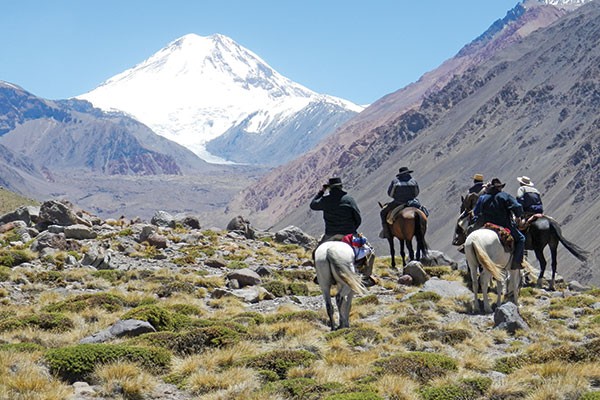
When Paul Ebbs asked if I wanted to join him and Brian McLachlan on a ride in the Andes, I did not hesitate.
Our jump off city was Mendoza, Argentina. Here we relaxed and got ready for our adventure. The food, wine and people were wonderful. Everywhere were statues of St. Martin, the liberator of Argentina, Chile and Peru.
We were picked up from our hotel by Daniel, our host’s son-in-law and driven to the ranch through the vineyards which are fuelling the area’s prosperity, towards the mountains and Estancia El Puesto, the ranch of Raul Labat, our host.
We lingered over lunch on the terrace of the ranch house, getting to know Raul and the other adventurers. After lunch, at the Real de La Mula Muerta — the Corral of the Dead Mule — we met the five gauchos, our mounts and the pack string of horses and mules that would carry us over the Andes.
In the morning we rode into the mountains, quickly learning there are really only two directions in the Andes — up and down. Up and through a narrow Portilla (entry) that St. Martin and his army of gauchos travelled through to liberate Chile from Spanish rule. From over 14,000 feet above sea level we looked down on soaring condors. At this spot we spread some ashes of our friend, Mark Glaser, a mountaineer who had perished the previous year in an avalanche.
After long hours in the saddle, we arrived at the Refugio — a bare structure maintained by the Army to provide shelter. Each day we toured, following Faustino as he climbed up to viewpoints, crossed lava flows and descended into grassy valleys. The 22,500-foot Tupungato volcano and neighbouring San Juan glacier were often visible. Lunches were beef on a long skewer, roasted over a fire and served with cheese, bread, wine and water from glacier-fed rivulets.
The January days were warm, but glacier-cooled wind was a constant companion, as was frost at night at our elevation of 12,000 feet. Most days we saw guanacos (wild llamas) and once, a puma. The mild Tunuyan River that we crossed one morning became a roaring torrent to re-cross in the late afternoon, with rocks rolling under the force of the current; the melt from the glaciers multiplying the flow.
The horses and mules were tough, fit and well broke. Saddles were traditional gaucho rigs, a tree cinched down covered by layers of sheepskin and another cinch. Pancho, Rolensio and Horacio, under the watchful eye of head gaucho Faustino, took great pride in looking after the mounts and would not let us help in any way. Beno (shortened from Benesio) was the cook. He and his short-tempered mule had a well-practiced working arrangement, complete with an entertaining ritual of establishing who was to be in charge each day.
One long day of riding was to the Chilean border, following in the footpaths of St. Martin and his gauchos on a trail used to drive thousands of cattle to Chile. We passed the cairn and cross on the trail where 17 gauchos and 2,200 head of cattle perished in a blizzard in the 1940s.
The next day, Raul promised that Faustino would take it easy on us. All we did was climb for five hours to the base of the Castillo, a mountain that towered over our camp. The trip down was short as our horses slid down steep scree slopes and lava flows to the bottom of the valley. Five hours up, 45 minutes down.
Too soon our adventure was over. We rode the miles and years of history back through the Portilla to the ranch, Mendoza, and hot showers.
